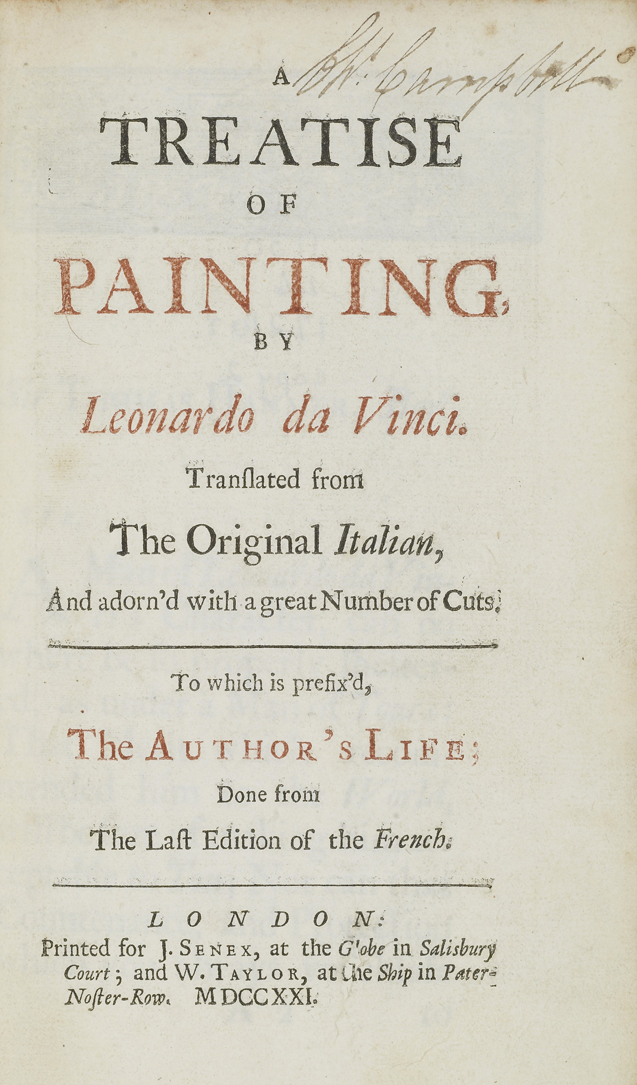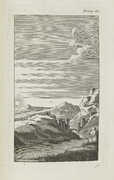
A Treatise on Painting, by Leonardo da Vinci
1721
Senex and Taylor, London
Illustrations:   | Chapter Display  |
I350I058
The Surface of every Opake Body, partakes of the Colour of the Transparent Medium, found between the Eye and that Surface; and by how much that Medium is more dense, and the space between the Eye and the Surface more great; by so much the Colour, which the Surface borrows from the Medium, is found more strong.
The Bounds or Contours of Opake Bodies, are so much the less visible as those Bodies are further removed from the Eye which views them.
The parts of Opake Bodies, will be the more strongly shadow'd or illumined, as they are nearer the dark Body, whence they have their Shadow, or the luminous Body that gives them light.
The Surface of every Opake Body, partakes more or less of the Colour of its Object, as that Object is more or less removed, or as it makes its impression with a greater or less force.
Those things which are seen between Light and Darkness, appear with a greater Relievo, than those which are seen, entirely either in Light or Darkness.
When in representing any distant Scene, you Paint your Figures bold and distinct, these in stead of appearing far removed, will be seen near at hand: Use so much Conduct and Discretion, therefore, in your Figures, as that they may show their Distances; nor in imitating any Object, whose bounds on account of their distance, appear dim and indistinct, must you scruple to Copy, even that dimness, and confusion in your Figure.
Distant Objects appear dim and confused in their Contours for two reasons; The first is, that they come to the Eye under so small an Angle, that their effect is like those of the smallest Objects; as the Nails of the Fingers, the Bodies of Insects, or the like Minute Bodies, whose littleness prevents the Eye, from discerning their Figure, or Parts: The second is, that remote Objects, have so much Air interposed between them, and the Eye, that it has the effect of a Fog, or some other dense Medium, tinging, and discolouring the Shadows of Objects, with its Whiteness, and stripping them of their natural obscurity, till they appear of a Blueish Tincture: that being the middle, between Black and White.
Though several Objects become invisible, on account of their distance, yet those illumined by the Sun, can never fail of making some impression on the Eye; the rest, which are unillumined, remaining wrapp'd up in Shadow and Obscurity; and since the Air becomes more gross, as it approaches nearer the Earth, those things which are found the lowest, will be the darkest and most confused, those more elevated, at the same time, appearing clearer and more distinct.
When the Sun reddens the Clouds, over the Horizon, with his Beams, those Bodies which by reason of their distance, participate of Azure, will be likewise found tinged with a share of this Redness; and this mixture or union of Red and Azure, will beautifie the Champaign, and render it extremely pleasing and agreeable. All the Opake Bodies illumined with this mingled Colour, will appear very bright, being seen to border mostly upon the Red; and the Air, will have a Colour like to that of Yellow Flower-de-luces.
The Air, between the Earth and the Sun, at the time of his rising or setting, will obscure the Objects found underneath it, more than any other Portion of the Hemisphere; it being here, that the Air is found more White, than in any other part.
Never draw the Terms or Contours of any Body terminating on another, or to which another Body serves as a Ground, too bold and apparent; but let it be rais'd and loosen'd from the Ground, of it self.
One White Curvilinear Body, terminating on another White Body, will have its Contour dimmer and more obscure, than any other of its illumined parts; and on the contrary, this same Contour, if found on a dark Ground, will appear brighter, than any other illumined part of the Object.
That Thing will appear the most separated and remote from another, which is seen on a Ground, of a Colour the most different from its own.
The Things which first lose themselves at a distance, are the Contours of such Bodies, as have the same Colour, and are placed over one another, as for instance, one Oak over another Oak, &c. At a greater distance, the extremes of Bodies, which have a difference in Colour, and which bound on each other, are found to disappear, as Trees and Plough'd Ground, Walls, the Ruins of Houses, the Fragments of Rocks or Mountains; lastly, at a distance still greater, those things which are usually the most conspicuous, as bright and obscure Bodies terminating on each other, dwindle and vanish.
Among Bodies equally elevated above the Eye, that which is placed at the greatest distance, will ap pear the lowest; and of several Bodies ranged equally below the Eye, that will appear the lowest, which is placed the nearest.
In a Landskip which takes in far distant Objects, those, found on the Banks of Rivers, or Lakes, will appear less, than those seen at a distance from them.
Among Bodies of equal densities, those nearest the Eye, will appear the least dense; and on the contrary, those more dense, which are more remote.
Every Object appears bigger, as the Pupil of the Eye which views it is larger. This you may be convinced of, by looking at one of the Heavenly Bodies through a small Pin-hole made in a Paper; for that little Perforation admitting but a small share of the Light of the Body, the Object becomes diminished, and loses of its usual Magnitude, in proportion, as the hole of the Paper, is smaller than the Pupil of the Eye.
The Air being replete with gross Vapours, the Contours of Bodies invested by it, become dim and confused; and the Bodies themselves appear larger, than they are found to be in effect. The reason is, that though the Linear Perspective, does not diminish the Angle under which the Image of the Object strikes the Eye, yet the Perspective of Colours, or the Aerial Perspective throws back the Body, and places it at an imaginary distance, much greater than its real one; so that while the one removes the Object from the Eye, the other preserves it, in its natural Magnitude.
When the Sun is near his setting, the Dews which are then observ'd to fall pretty plentifully, thicken and condense the Air; so that all Objects unillumined by the Sun, remain dark and confused; those which are illumined, at the same time, receiving a Tincture of Red, or Yellow, according as the Sun is found in the Horizon. Further, those things then illumined by the Sun, will be very evident, and will strike the Eye very sensibly, especially Buildings, the Houses of Towns and Cities, and Castles in the Country; for their Shadows will be very obscure and deep, and that opposition, found between the brightness of their upper illumined parts, and the darkness of their lower and shadow'd ones, will give them an uncommon Force, and Relievo.
A Thing illumined by the Sun, is further illumined by the Air; whence arises two several Shadows, whereof, that will be most obscure, whose Central Line is directed towards the Centre of the Sun: And observe that the Central Lines of the two Lights, Primitive and Derivative, being continued within the Shadow, will form the Central Lines of the Primitive and Derivative Shadows.
'Tis a fine sight, to observe towards the Evening, how the Tops of Houses, Towns, Castles, Trees, and other elevated Objects, are illumined and gilt with the Beams of the setting Luminary; all the rest at the same time remaining dim, and indistinct, receiving no Light but from a dusky Air, and that too weak to distinguish their Lights from their Shadows. Now those tall Objects, being thus tinged and enlighten'd with the Sun, to represent them in a Painting, you must take some of the Colour wherewith your Sun is Painted, and mingle it with the Light parts of all the Objects supposed to be illumined by it.
It often happens, that a Cloud appears obscure, without receiving a Shadow from any other Cloud: This is owing to the situation of the Eye, which being found near the Cloud, sees only so much of it, as is shadow'd; as in another place, or at a greater distance, it wou'd discover both its shadow'd and illumined sides.
Of two Bodies equally high, that which is seen at the greatest distance from the Eye, will appear the lowest. Thus of the two Clouds represented in Figure 9. Tab. 2. though that nearest the Eye, be really the lowest, yet in appearance it will be the highest; the Section of the visual Rays of the first and lowest Cloud, on the perpendicular A N, being found between the Points M A, and that of the second and higher Cloud, between the Points M N, which is below A M. It may likewise happen, by an effect of the Aerial Perspective, that of two Clouds, the one whereof is illumined by the Sun, at his rising or setting, the other at the same time remaining obscure and unillumined, the latter, though really the lowest, and the nearest, shall yet appear both the remotest, and the highest.